Metascience
Project Saint Peter and the Golden Phone
By Erland R. Babcock
†
|
Erland Babcock
Burlington, MA
Email: etrains (ett) rcn.com
Born: Boston, Massachusetts, 1928
Graduate Rindge Technical High School
Double Veteran: Graduate of Sheephead Bay Maritime Academy (New York). North Atlantic war zone and the Pacific war zone. U.S. Army (signal Corps)
|
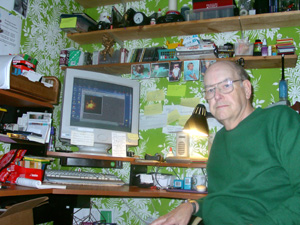 |
|
Graduate: National Radio Institute 1950 plus a number of individual courses
Graduate: School of Modern Photography (2 awards)
Graduate: 3-credit course Scientific Photography (head of the class)
Work: Title Senior Electronic Technician and part time photographer
5 years at M.I.T Lincoln Laboratory (When the SAGE computer ran on vacuum tubes...helped change to transistors) The computer that was the forerunner of todays AWAC system
2 Years MITRE Corp. (M.I.T. Research Engineering). Communications
8 Years on the M.I.T. Campus Radio Astronomy...When that finished worked in the Magneto-Hydro-Gas Dynamics Lab (plasma physics, shock tubes)
AVCO: Senior Tech. Calibration and repair of instruments. In charge of on site calibration.(3 years)
OmniMedia (2 years) System specialist closed circuit TV also head of photography (Company went out of business)
Lowell Technological Institute: Professional Technician responsible for the sophmore lab in electrical engineering (5 years). Lowell Technological Institute becomes University of Lowell and then becomes University of Massachusetts (Lowell)
Develope and direct the audio/video laboratory in the college of engineering (a fancy name for a TV recording studio)..18 years
Retired from the University 1994
Former member: Society of Motion Picture and Television Engineers
Former Member: The New York Academy of Sciences
Ham Radio License: Call sign...K1GPH held for about 50 years (still hold)
A number of certificates from various courses.
Former license (Massachusetts Motion Picture Projection)
I was into EVP before I met George meek. Met George through his announcement in the National Inquirer (newspaper). After reading sent him a letter on University letter head. He and his lovely wife paid me a visit at the University. He asked me to write a proposal for a grant, which I did and he granted it. It was the beginning of a long and interesting affair. Through George I met a lot of interesting people like Ernst Senkowski, Hans Heckmann and I worked together. He at his place and I at my home. My home has been visited by many people when the lab was running. One day George came with a man in a Limousine. This man who was with George turned out to be the husband of Roberta Pew Bandy (Owner of Sun Oil Corp). John Bandy. I have a picture of John shaking hands with President Regan. That is pritty high up on the ladder. George knew and associated with a lot of important people in this world. When John died the important funding dried up.
|
[Editor’s note: George Meek’s Spiricom device succeeded in providing 20 hours of historic, unprecedented dialog between Heaven and Earth between 1979 and 1982 (search on this website for “Spiricom”). George announced the Spiricom results to the world at the National Press Club in Washington DC, Easter morning of 1982. After the remarkable success of Spiricom, Meek and his Metascience team embarked on a new project that they hoped would take ITC to the next level - - open communication channels with the highest spiritual realms. George called the effort Project St. Peter, and although few people have ever heard of it, the project deserves attention because of the high level of technology developed to penetrate the spirit worlds - - technology that has not been approached even today, 17 years later, to the best of my knowledge. ITC pioneer Erl Babcock was one of the key figures in that project, compiling detailed notes along with dozens of illustrations and photos into 26 journals during the late 1980s. Erl sent me some of the images and notes, along with several letters describing the project. The team’s research and development involved high-power lasers, Tesla coils, a large parabolic dish, and various other high-tech apparatuses. The notes and pictures from the project made it clear to me that there was a sense of adventure and enthusiasm they all shared beginning with the success of Spiricom in the early 1980s and lasting until the new project ended a decade later. Erl has woven that information into the following report, which I have edited. - - Mark Macy]
In the late 1980s Project St. Peter, the next step beyond Spiricom, was a multi-faceted effort launched by Metascience president George W. Meek to access the higher realms of spirit through such efforts as:
Overview: The Rise and Fall of Project St. Peter
We started out in my basement. I provided several pieces of equipment to the project as well as most of the optics. Lots of additional equipment was purchased with the help of outside funding. After three years, George decided that we needed more room, so the project was moved, first to George’s home in North Carolina, then to a mountaintop in Wyoming. After the project left my basement, I remained involved as a consultant, and much of my personal equipment was now being moved around the country. At home I continued to work on a few ideas that didn’t require the lab.
The source of funds, a man who strongly supported our efforts, died in the late 1980s, and his family refused additional support. Even I got a letter from their lawyers announcing the end of funding. To carry the project that far and then to have it fall through the cracks must have hurt George to the bone. A few years later his wife Jeannette died, and others left him. I remained a close friend, a telephone call away, until the end. A year before George’s death in 1999, the project had been scrapped, and most of the equipment was being stored in a warehouse in northern New Hampshire. It took me several trips to retrieve the devices and supplies that I had lent to the project in the beginning.
George Meek was truly a great man. He might have made some mistakes in judgment at times and lost some good people, but his ITC achievements were amazing. From the beginning of the Project, George began to employ a series of psychics to help him resume building an ITC bridge. The first was Lucille McNames, with whom I still have contact. Today Lucille is 96 years old and lives in Colorado. She’s still as sharp as a tack when I talk to her on the phone or receive one of her letters. George probably should never have let her go.
George's second psychic showed up at his door one day claiming to be sent by spirit. She was married with one child, a boy. I have photographs of the family. Everything went fine for some months, as reams of information poured through the channel from the other side. Then one day George decided to do a little checking. The psychic was channeling information supposedly that came from certain famous people, and George knew a lot of important and famous people, some of whom had known some of those departed personalities during lifetime. George asked his acquaintances if the channeled messages really represented the minds, thoughts, and personalities of their loved ones on the other side. To George’s dismay, every reply came back negative, prompting George to do further investigation of other transmissions from that psychic. She left the Project shortly before the funding ran out. Eventually George came to the conclusion that all the material that had been channeled and written by this psychic - - and there were boxes and boxes of papers - - all had to be thrown out. Another blow to poor George. That was the end of the entire project, Project St. Peter.
The Good Years
But let’s go back to the early years when there was a lot of excitement about the leading-edge technologies that we developed in my basement from 1985 to 1987. Probably the best way to give you a flavor of the project is with a photo journey.
Laser Communication System
The following photographs are of the laser system as of 1985 March 23. Refer to the diagram below (Scan0008) for a schematic of the layout.
Click on the images to enlarge them
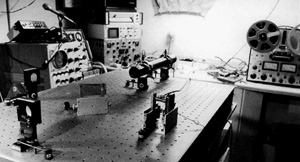
|
Meta 1
The laser system being installed on my workbench.
|
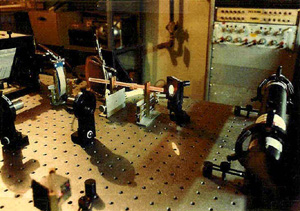 |
Laser is running. (Note quartz rod and speaker are lit up by beam.) The quartz rod is pointed at a kynar film strip. This in turn is plugged into a tape recorder (shown in the first photo). |
|
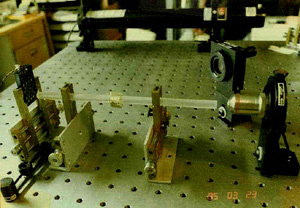
|
The 8-inch quartz rod with a small R.F. test coil. In this case a microgenerator (fancy solar cell) is being used in place of the Kynar film.
|
| |
|
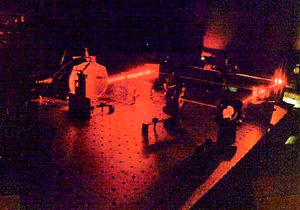
|
The laser in action.
|
|
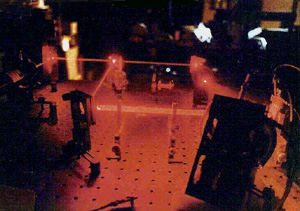 |
Another shot of the laser in operation. |
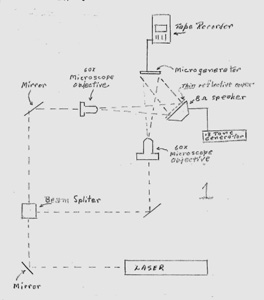 Scan 0008 |
This diagram of the laser communication system was based on the subject of holography. You might call it holographic audio. The use of light as a detector. The micro-generator was replaced by a Kynar Film Strip which is sensitive to light. Another modification was to put a thin reflective covering over the speaker, which eventually got replaced by a small front surface mirror. This was all happening in March 1985. Nine years later we were still trying to perfect a system. Edison had to try over a thousand times before he found the proper material (tungsten filament) for the light bulb. This diagram is but one of many with various adjustments. My 26 journals are filled with notes, and this diagram is in Journal #4 dated 15 Sept. through 15 April 1985, consisting of 289 pages. The majority of the ideas in these journals were mine. Some worked to some extent, and some did not. I still had to follow George's instructions. Some of the ideas that I thought were most likely to work are in the journals. George always looked forward to reading the journals. I sent him copies of every six pages or so. We did a lot of work with optics. It was just a few years ago that I put together (on my own) a very inexpensive interferometer using an ordinary laser pointer, and it worked to some extent. I did make an audio recording, but you have to be used to listening to the recording to make anything serious out of it. Once you get used to listening to the steady tone you can hear a message. But, you have to get rid of repetitive noises and listen for the steady tone between the noises. The system was sensitive down to a half wavelength of light, and it was also sensitive to vibration, and that is what caused the repetitive noises - - that and wind currents. The system needs to be built on a steady platform with micro-adjustments which I cannot afford to develop at this time.
|
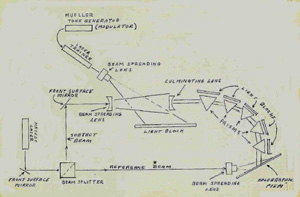 |
Proposed modification for use in holography. 1987 February 27. Prisms are used to refract (bend) the beam. Erland R. Babcock. Project St. Peter, Angel 1 Laser System. Not to scale. |
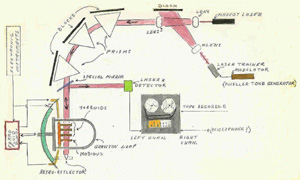 |
Project St. Peter: System Layout Diagram. 1987 March 2. Angel One. Erland R. Babcock, Burlington, Massachussetts. Not to scale.
* Detects center of beam only.
|
Parabolic Dish
A little explanation about the big dish. When it was completed (it never was completed here in my basement) you were supposed to be able to put a sheet of paper inside the large loop that stood out front. The paper would have your question on it and it would disappear into another dimension. Some time later it was supposed to come back with the answer.
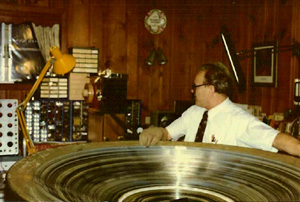 |
Hans Heckmann is winding the Metglass on the dish. He used seven 14½-inch reels. The picture gives you some idea of the size of the dish and how much work went into winding it. And that was only a small part of the experiment. The dish had large toroid coils in front of it that were liquid cooled. |
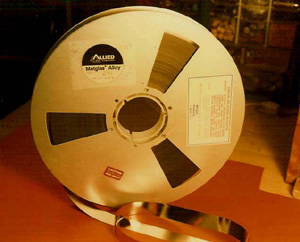 |
A roll of Metglass that Hans Heckmann used to wind into the large parabolic dish. |
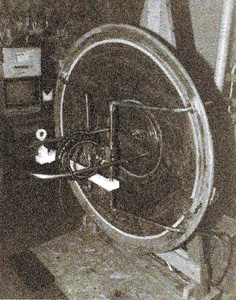 |
The dish was part of a larger laser system. One laser was used to modulate another laser. Because of the configuration of my cellar there was a need to bend the beam, and that was the job of the prisms. Eventually the beam went though the toroids and hit an optical retroreflector, which sent the beam back on itself to cancel out any noise. The toroids were cooled by pumping fero fluid through them. The dish being wound with metglass formed one heck of an inductor. The whole works was supposed to create a resonant vortex at the place where you put the paper. We had run the system up to 400 watts, but there was one insurmountable problem. That dish was facing my gas meter for the house, and my wife was against an explosion happening in our basement. At that point it was decided that the whole system was to be moved to North Carolina. It stayed there for awhile and they played with it down there, but for some unknown reason they did not get it working like it worked here in my basement. Eventually it was moved to a mountaintop out in Wyoming. |
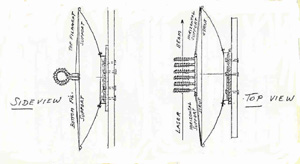 |
Illustration (top and side views) of the dish. |
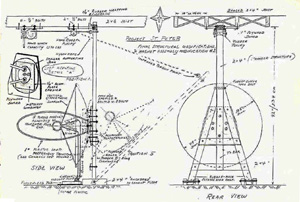 |
Project St. Peter. Final structural modifications, and magnet assembly modification #2.
Rear view, true scale 1 : 125. 1986 May 26, sketched by Hans J. Heckmann.
The horizontal tubing serves as magnet support and carrier of ferro-cooling fluid.
The loop (see detail “A”) above is mounted on a circular aluminum plate which is sitting on epoxy-covered Metglass windings and is held by a single bolt in the exact center of the parabolic dish. This allows turning the loop into any position if fine adjustments are desired.
|
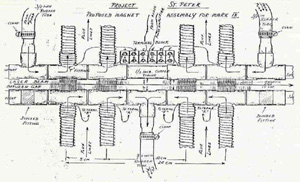 |
Partial drawing showing gap details of a 4-toroid assembly. (1986 May 18, Hans J. Heckmann).
Note: Toroid windings are uniform and closely spaced. Use 18 or 20 AWG enameled copper wire. Suggested DC resistance of each toroid = 8 ohms. (Terminal block shows parallel connection giving load resistance of 2 ohms.)
Scale 1 : ¾ |
Other Equipment Used in the Project
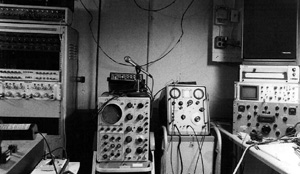 |
Miscellaneous equipment used in Project St. Peter. |
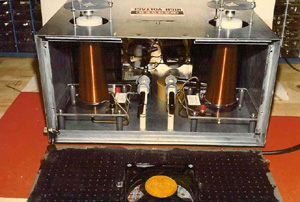 |
A high-voltage Tesla Coil Audio Frequency Generator was built by Hans Heckmann. |
We also produced a number of interesting images using video feedback techniques. A number of these have been published around the world. A couple of them were published by Dr. Ernst Senkowski in Germany. When I had my TV studio at work I would use it to experiment when I had free time. I had a good contact with the head of the electrical engineering department, who was also head of the optics lab, and I got permission to use the lab anytime I wanted. Had a lot of fun with lasers.
Finally, about the “Golden Phone.” It was the audio portion of the project - - designed as a special FM receiver with a warble board. It never reached maturity.
Some results:
|
The following is taken from the book "Instrumental Transcommunication" chapter B 12.5 by Prof. Dr. Ernst Senkowski
|
|
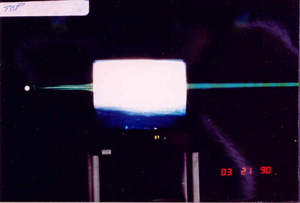
Ill. 26: PHOTOGRAFIC EXTRA:
GREEN LIGHT RAY
ERLAND R. BABCOCK - USA
|
Within the scope of his TV experiments in the audiovisual laboratory of the Lowell University, BABCOCK intended to photograph in the darkroom a scene visible on the screen. The photo (Ill. 26) shows left of the apparatus, on its horizontal line, a light source of about the size of a dot, which is surrounded by an annular appearance (of interference?). From this point of start, a slender green light ray extends towards the screen, accompanied by two weaker collateral rays. In front of the screen, this bundle of rays disappears, but becomes visible again on the right side, and is almost periodically sequenced in longitudinal direction by lighter and darker cross strips. While taking the photo, BABCOCK did neither perceive the light source, nor the green ray. |
| |
|
-
(Editor’s note: Having observed the evolution of ITC in the States and in Europe, the friendship between George Meek and the Harsch-Fischbach couple in Luxembourg, and the collaboration of the Timestream spirit group (who worked with the Harsch couple) and the Lifeline spirit group (who worked with Metascience), I’m convinced that it was the dedicated efforts of Project St. Peter that opened the doors to ethereal intervention, which made the miraculous contacts in Luxembourg possible. So the evolution of ITC has been the result of close collaboration and friendship on both sides of the veil. When such close international and interdimensional friendships, free of fear and doubt and envy, are renewed in the future, whether in two years or in two centuries, the miracles of ITC will resume. Of that I am certain. - - Mark Macy) December 2004
-
(Webmaster's note: David Babcock as the heir of
Erland Babcock allowed us to publish this information on our website. -- Rolf-Dietmar
Ehrhardt) September 2008
|
You are visiting our website: W rld ITC.org To reach our homepage click here please. rld ITC.org To reach our homepage click here please. |


















